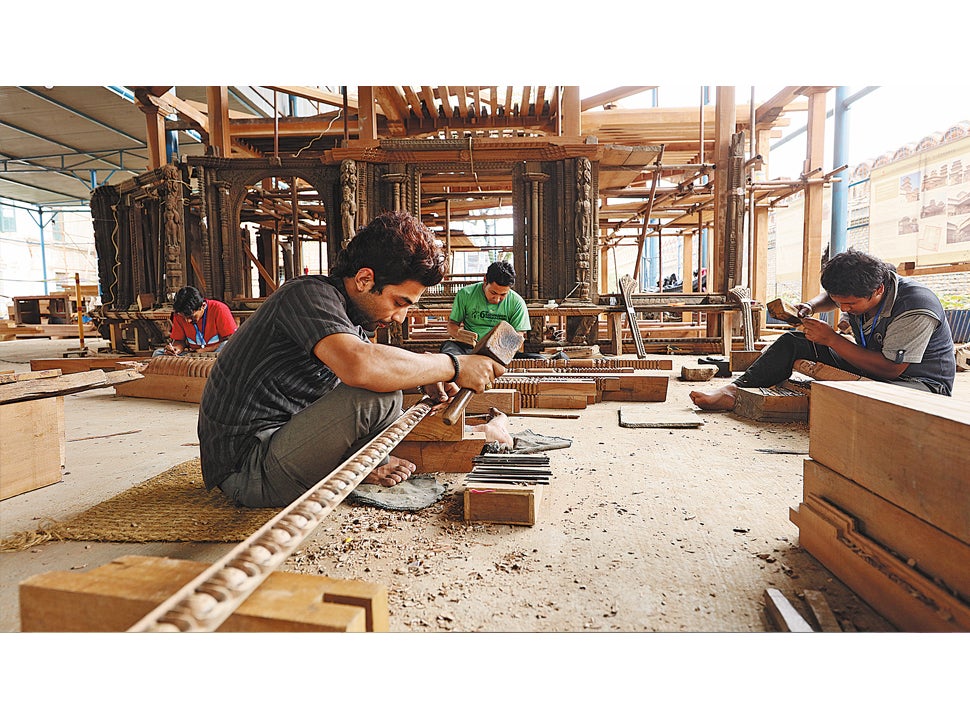Heritage of collaboration
THE ARTICLES ON THESE PAGES ARE PRODUCED BY CHINA DAILY, WHICH TAKES SOLE RESPONSIBILITY FOR THE CONTENTS

Standing on the top storey of Basantapur Palace in Nepal, Yuan Mengxi has a hard time relating today’s reality compared with what she saw seven years ago.
The palace complex in the middle of Durbar Square in the country’s capital, Kathmandu, was badly damaged in an earthquake in April 2015. The nine-storey palace, a tourist landmark, had been inscribed in the UNESCO World Heritage List in 1979.
The palace not only has great historical significance but is also an architectural feat.
“You can see the whole place from here, and everything is beautiful and in order,” says Yuan, 33, who works for the Chinese Academy of Cultural Heritage in Beijing. She is in Nepal to oversee the restoration of the palace.
She made her first work trip to Kathmandu in October 2015, six months after the earthquake shook the city.
She was in shock seeing the city just after the quake, she says. Heritage buildings in Durbar Square were reduced to rubble, with exquisite wooden statues buried and scattered over a wide area. “Kathmandu valley was still shrouded in the dust from the quake,” she says.

In the aftermath of the tremors, both the Chinese and the Nepali governments initiated a project aimed at restoring the nine-storey Basantapur Palace complex.
Work began in August 2017. The Chinese Academy of Cultural Heritage undertook the restoration work under the guidance of the National Cultural Heritage Administration of China. It is among China’s largest cultural heritage restoration foreign aid projects that had been conducted in six countries by the end of 2020.
China offered technical and professional support to the project, which was a challenging job because the top three storeys of Basantapur Palace had collapsed.
About 80 per cent of the complex walls suffered varying degrees of deformation and cracking, with more than 10,000 wooden components, both structural and decorative, undermined.
In addition, the complex remained open to visitors, so the Chinese team conducted a risk assessment and built a safety passage for the public.
China’s efforts in restoring the palace were recognised recently by Damodar Gautam, director general of Nepal’s Department of Archaeology.
Chinese experts consulted the Nepali side on how to preserve the complex’s traditional value, design and originality, Gautam says.
“They were very cautious about maintaining the authenticity, integrity and value of the world heritage site.”
Based on research of the earthquake damage and the structural features of the palace, the team moved to reinforce the building.This was done by means of adding material that aids the structure’s ability to absorb shock. The material is put inside nodes placed at specific junctions around the building.
This enabled them to improve the complex’s quake resistance with minimal intervention. The Chinese team also got a patent in China for the use of this technology.
In addition, as the complex had numerous fine and exquisite wooden structures and sculptures, the team used as many original components as possible, and all the damaged carvings in the elaborate windows were restored.
About 85 per cent of the old wooden components were repaired and assembled in the original location during the project, and about 3,700 pieces of wooden components were newly built as supplementary parts for the project. The more old wooden components were applied, the less historical information was lost.
Manhari Maharjan, a Nepali sculptor who worked on the project, says the Chinese team could identify the carvings of designs.
“If a window needed to be repaired, the Chinese team would examine the window and invite us to discuss whether something was missing.”
Personnel on both sides then compared the existing windows with pictures of the original ones to find and develop missing parts before they “created a window like the original one”, Maharjan says.
Yuan is now busy putting together a permanent exhibition displaying the restoration process of the Basantapur Palace complex.
“We hope it will help carry forward cultural heritage restoration concepts and technology among the public.”
Xinhua contributed to the story.

Bookmark popover
Removed from bookmarks